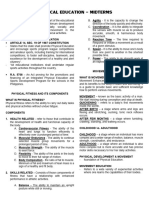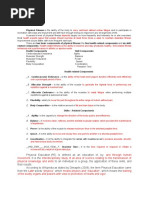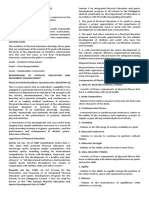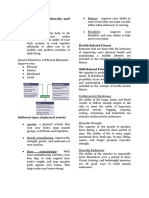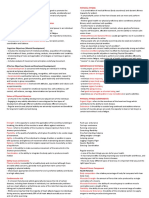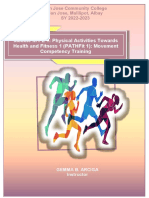0 ratings0% found this document useful (0 votes)
28 viewsUntitled
Untitled
Uploaded by
Alexie Jade Martin1. Physical education aims to promote health and fitness through physical activity. It focuses on physical, mental, social, and emotional development.
2. Fitness includes both health-related and skill-related components like cardiovascular endurance, muscular strength, flexibility, coordination, and reaction time.
3. The H.O.P.E model for physical education focuses on health through engaging activities, keeping students active, and promoting lifelong physical activity and healthy lifestyles.
Copyright:
© All Rights Reserved
Available Formats
Download as DOCX, PDF, TXT or read online from Scribd
Untitled
Untitled
Uploaded by
Alexie Jade Martin0 ratings0% found this document useful (0 votes)
28 views6 pages1. Physical education aims to promote health and fitness through physical activity. It focuses on physical, mental, social, and emotional development.
2. Fitness includes both health-related and skill-related components like cardiovascular endurance, muscular strength, flexibility, coordination, and reaction time.
3. The H.O.P.E model for physical education focuses on health through engaging activities, keeping students active, and promoting lifelong physical activity and healthy lifestyles.
Copyright
© © All Rights Reserved
Available Formats
DOCX, PDF, TXT or read online from Scribd
Share this document
Did you find this document useful?
Is this content inappropriate?
1. Physical education aims to promote health and fitness through physical activity. It focuses on physical, mental, social, and emotional development.
2. Fitness includes both health-related and skill-related components like cardiovascular endurance, muscular strength, flexibility, coordination, and reaction time.
3. The H.O.P.E model for physical education focuses on health through engaging activities, keeping students active, and promoting lifelong physical activity and healthy lifestyles.
Copyright:
© All Rights Reserved
Available Formats
Download as DOCX, PDF, TXT or read online from Scribd
Download as docx, pdf, or txt
0 ratings0% found this document useful (0 votes)
28 views6 pagesUntitled
Untitled
Uploaded by
Alexie Jade Martin1. Physical education aims to promote health and fitness through physical activity. It focuses on physical, mental, social, and emotional development.
2. Fitness includes both health-related and skill-related components like cardiovascular endurance, muscular strength, flexibility, coordination, and reaction time.
3. The H.O.P.E model for physical education focuses on health through engaging activities, keeping students active, and promoting lifelong physical activity and healthy lifestyles.
Copyright:
© All Rights Reserved
Available Formats
Download as DOCX, PDF, TXT or read online from Scribd
Download as docx, pdf, or txt
You are on page 1of 6
Physical Education Reviewer
Lesson 2: Fitness
Lesson 1: Physical Education Is defined as 'the ability to carry out daily
tasks with vigor and alertness, without
Physical Education came from the Latin
undue fatigue, and with ample energy to
words “physica” which means physics and
enjoy leisure-time pursuits and respond to
‘’education’ which means training of the
emergencies.
bodily organs and powers with a view to the
promotion of heart and vigor.
A. Health - Related Physical Fitness Term
Key Goals of Physical Education and Muscular Endurance – is defined as the
Wellness ability of the body to perform repeated
exercises without getting tired.
A. Physical Development
- An individual who actively participates Cardiovascular Endurance – can be defined
in any physical activity can have and as the component which helps to determine
sustain good health and elevated if the heart and lungs are working in
fitness level. coordination.
B. Mental Development Muscle Strength – can be defined as the
- An individual who develops mental capability of the muscles to lift weight.
capacity as information is attained
Flexibility– is the range of motion available
and understands the right approach
in a joint. It is affected by muscles length,
and rules of the games as well as in
joint structure and other factors.
different aspects of physical
education program. Body Composition – is the ratio of fat to
C. Social Development muscle. Minimum of fat and maximum of
- The ability of a person to act lean mass is a sign of a healthy and fit body.
accordingly in a situation or event; To know your fitness level you need to
the commitment of a person to understand your body composition.
develop appropriate interaction.
D. Emotional Development
B. skill - Related Physical Fitness Term
- Refers to how the students regulated
their expressions and emotions Balance-is the maintenance of equilibrium
through their experiences. while stationary or while moving.
Agility - to rapidly change the position of
the entire body in space with speed and
accuracy.
Coordination– relates to the ability of the Morphological Fitness
person to use the senses, such as sight and
- its main focus is the body
hearing together with body parts in
composition specifically on the level
performing motor task smoothly and
of body fats contents
accurately.
- its circumference and the fats
Power– is considered to be a combination distribution to the areas in our body.
of strength and speed. It has also been
defined as the ability to exert muscle force
quickly.
Reaction Time – it relates to the time
elapsed between stimulation and the
beginning of the reaction to it.
Speed – is the ability of a person to execute
motor movements with high speed in the
shortest period of time.
Lesson 3: Physical Fitness
C. NON – PERFORMANCE FITNESS TERM HEALTH-RELATED FITNESS
Physiological Fitness BODY COMPOSITION- Measures the
- It is one component of fitness where cardiovascular endurance.
its focus is in the level of physical BMI CLASSIFICATION
activity a person does habitually. 18.0 BELOW UNDERWEIGHT
- It more focused on the performance 18.5-23.0 NORMAL
of whole body and how the body
23.5- <30 OBESE
reacts to the different activity that we
do.
3-MINUTE STEP TEST- Measures the
Metabolic Fitness
cardiovascular endurance.
- is focused on the metabolic PUSH-UPS- Measures endurance of
performance of the body especially shoulders and arm muscles.
on the lipids in our blood profile and
its sensitivity to insulin. BASIC PLANK- Measures strength/stability
of core muscles.
- Metabolic training is for strength,
cardio, full body, rest periods and ZIPPER TEST- Tests the flexibility of shoulder
variety. girdle.
SIT AND REACH- Measures the flexibility of B. Keep the students on the go most of
the hamstring and lower back. the class time;
SQUAT TEST- Determine the level of leg C. Engage the students to participates
endurance. regardless of ability
D. Contribute to overall physical activity
participation;
SKILL-RELATED FITNESS
E. Provide students to proportion of the
STICK DROP TEST- Measures the time to
recommended amounts of physical activity;
respond to a stimulus.
F. Prepare students for an active
JUGGLING- Measures the eye and hand
lifestyle, including one that continues into
coordination.
adulthood.
STORK BALANCE STAND TEST- Assesses
one’s ability to maintain equilibrium.
MAJOR STRAND OF HOPE
STANDING LONG JUMP- Measures the
strength and power of the leg muscle. STUDENT- The youth at the center of the
model.
HEXAGON AGILITY TEST- Measures the
ability of the body to move in different INTERPERSONAL- The families, teachers,
directions quickly. peers who influence the individual.
ORGANIZATIONAL- School for both
organizational and physical structure.
COMMUNITY- The surrounding built and
natural environment and opportunities that
support the activity.
POLICY- The policies, rules, procedures and
Lesson 4: H.O.P.E expectations that influence each of the
above.
Intention to Change Eating Habits for Good
HEALTH OPTIMIZING PHYSICAL EDUCATION Health
HOPE- it focuses on the following main 1. Eat all the food you enjoy, BUT do it
goals in small quantity;
A. Focus on health level of fitness 2. Always have a plan; it is important to
through engaging with games and sports; balance your meal for the rest of the day;
3. Focus on the Good-for-you foods; 3. HAD A CREATIVE MIND
healthy and nutrients – rich foods will help
4. PHYSICAL STRENGTH AND ENERGY
to stable the blood sugar and help your
brain to signal your belly that you are full; 5. HELPS IN ONE’S WEIGHT
ADMINISTRATION
4. Always eat green leafy vegetables but
you can always incorporate high-flavoured 6. STRONG EMOTIONAL STABILITY
add-on;
5. Spend more time preparing your
food, it is linked to better eating habits;
6. Eat lunch like a KING. Lunch time is
when your body’s digestion is at its peak,
you can feel your body when it actually
needs a fuel;
7. Have a better diet, think of food not
only as a body fuel for energy but also a
pleasure.
8. Eat the rainbow foods, green, orange, HEALTH, WELLNESS AND HEALTHY
purple, red, yellow vegetables. They will LIFESTYLE
supply your body with a range of disease – - INCREASE YEARS AND QUALITY
fighting phytonutrients; HEALTHY LIFE STYLE AND ELIMINATES
9. Know where your snacks are; always HEALTH INCONSISTENCY
have an emergency stash of snacks, like - INCREASE INCIDENCE OF PEOPLE
yogurt, nuts, Dried fruits, and nitrate free REPORTING “ACTIVE DAYS”
jerky; - INCREASE INCIDENCE OF PEOPLE
REPOSTING “HEALTHY DAYS”
10. Follow the 80/20 rule; eating 80%
healthy foods of the time and save 20% for - INCREASE ACCESS TO HEALTH
splurges INFORMATION AND SERVICES FOR
ALL PEOPLE
THE POWER OF SLEEP
S.M.A.R.T.
SPECIFIC – A DEFINED AND CLEAR GOAL
THE BENEFITS OF A GOOD NIGHT SLEEP SETTING.
1. SHARPNESS OF ONE’S MIND MEASURABLE – IT SHOULD BE CLEARLY
2. BECOMING MORE PRODUCTIVE MEASURED TO SEE THE PROGRESS IN
ACHIEVING YOUR GOALS.
ACTION ORIENTED – AN OUTLINE OF YOUR 1. HEALTH – Is having a positive feeling
DETAILED ACTIVITY FOR YOU TO BE ABLE TO on a achieving a quality of life and a body
SEE THE PROGRESS IN COMPLITING YOUR that is free from disease
TARGET
2. HEALTH GOALS – Is setting an activity
REALISTIC – CREATE AN ACTIVITY THAT IS specifically for achieving your health and
ACHIEVABLE IN AN NATURAL WAY, DO NOT wellness objectives.
FALL IN TO TRAP THAT OFFER FASTER
3. HEALTH LIFE EXPECTANCY – Is an
RESULT BUT IT AN UNHEALTHY WAY
estimate of how many a person might be
TIMED – MAKE A DEADLINE IN ACHIEVING expected to live.
YOUR GOAL, SO YOU CAN TRACK YOUR
4. WELLNESS – Is a reflection of optimal
BODY DEVELOPMENT AND PROGRESS
health where the body is functioning to its
full potential in all aspects of line, work and
society
PHILIPPINES AGE STRUCTURE
As of the beginning of 2015 according to our
estimations Philippines had the following LESSON 5: Principles of Exercise
population age distribution:
Overload- Training must be raised you a
higher level than normal to create the extra
- Percentage of the population under demands to which your body will adapt.
15 This can be done in the three ways:
- Percentage of the population ✓ Increase the intensity – run faster
between 15 and 64 years old
✓ Increase the frequency – train more
- Percentage of population 65⁺ often
✓ Increase the duration – train longer.
Specificity- Training must be specific to the
DIMENSION OF HEALTH AND WELLNESS sport or activity, the type of fitness required
A. Emotional - mental wellness B. and the particular muscle groups.
Intellectual wellness Progression- As your body adapts to
C. Social Wellness D. Spiritual wellness training, you progress to a new level of
fitness. To then take this to the “next level”,
E. Physical wellness
a gradual increase in intensity is needed to
create an overload.
Reversibility- The effects of training are
reversible. If exercise is reduced in intensity
or even stopped, the benefit can be lost
quickly.
Adaptation- With continued practice, your
body will eventually turn a new sport,
activity or movement skill into second
nature.
Individual Differences- Each person has a
different response to an exercise or training
program and each person needs to exercise
and training accordingly.
You might also like
- Physical Education ReviewerDocument7 pagesPhysical Education ReviewerMaria Buena Mae Esguerra100% (1)
- Ingredients Needed in Preparing DessertDocument48 pagesIngredients Needed in Preparing DessertElaine Portia LagundinoNo ratings yet
- P. E. 1 ModuleDocument6 pagesP. E. 1 ModuleCABAGSANG KYLA T.No ratings yet
- UntitledDocument6 pagesUntitledAlexie Jade MartinNo ratings yet
- PE & Health Reviewer: 11-STEM - SEM 1 2022Document3 pagesPE & Health Reviewer: 11-STEM - SEM 1 2022MARIAL JUNE BALDONo ratings yet
- Physical Education ReviewerDocument6 pagesPhysical Education ReviewerCharo CruzNo ratings yet
- PE-MIDTERMSDocument4 pagesPE-MIDTERMSdanilo laranoNo ratings yet
- Lesson 1 and 2: Physical Fitness Is The Ability of The Body ToDocument3 pagesLesson 1 and 2: Physical Fitness Is The Ability of The Body ToMarie Ann JoNo ratings yet
- Physical Fitness and Its ComponentsDocument5 pagesPhysical Fitness and Its Componentstidulajohnmichael1997No ratings yet
- Pe ReviewerDocument3 pagesPe ReviewerJhanela FayeNo ratings yet
- Pe ReviewerDocument7 pagesPe Reviewergalletoreamay567No ratings yet
- Physical Education 1Document4 pagesPhysical Education 1Jaycee PascualNo ratings yet
- Concept of Physical FitnessDocument3 pagesConcept of Physical Fitnessken lacedaNo ratings yet
- PathFit Reviewer Jamilah Valdez BsBa 1ADocument10 pagesPathFit Reviewer Jamilah Valdez BsBa 1Adaguigemar6No ratings yet
- Movement Enhancement 1stDocument8 pagesMovement Enhancement 1stLuna ValeriaNo ratings yet
- Pathfit Final ExamDocument8 pagesPathfit Final ExamamorettamabNo ratings yet
- Physical Education 1 Reviewer by JasminDocument4 pagesPhysical Education 1 Reviewer by JasminNina JasminNo ratings yet
- DLL Hope 2 Co1 Olea TuazonDocument4 pagesDLL Hope 2 Co1 Olea TuazonDandref ReyesNo ratings yet
- Mental Emotional Social Aspects: Perform One's Daily Task Efficiently Without Undue FatigueDocument16 pagesMental Emotional Social Aspects: Perform One's Daily Task Efficiently Without Undue FatigueJustine MaganaNo ratings yet
- Physical EducationDocument7 pagesPhysical EducationEuniceNo ratings yet
- Introduction To Physical EducationDocument9 pagesIntroduction To Physical EducationJaymar LoloNo ratings yet
- Introduction To Human MovementDocument43 pagesIntroduction To Human MovementMike david SarinoNo ratings yet
- 2pat Fit - Module Week 1-8Document21 pages2pat Fit - Module Week 1-8Xxx100% (1)
- Unit 1: Cagayan State UniversityDocument5 pagesUnit 1: Cagayan State UniversityFrendick LegaspiNo ratings yet
- Lesson 3 - Basic Principles of Physical FitnessDocument20 pagesLesson 3 - Basic Principles of Physical FitnessJohn Michael AgustinNo ratings yet
- PE 104 Notes - Final-1Document22 pagesPE 104 Notes - Final-1Cheryl GabianaNo ratings yet
- 4-The Essential Components of Physical EducationDocument18 pages4-The Essential Components of Physical Educationrasthy jay caligdongNo ratings yet
- PEN-1-Module 1Document10 pagesPEN-1-Module 1chavezjuliajaffaNo ratings yet
- PATHFIT MidtermsDocument7 pagesPATHFIT Midterms2023200285No ratings yet
- Pathfit 1 ReviewerDocument4 pagesPathfit 1 Reviewerkayesayson25No ratings yet
- FITT 1 Updated HandoutsDocument25 pagesFITT 1 Updated HandoutsJolina VillalobosNo ratings yet
- Peds101 SGDocument3 pagesPeds101 SGBeatrice Dominique C. PepinoNo ratings yet
- FITT 1 (shortened)Document2 pagesFITT 1 (shortened)godkingjoshuaNo ratings yet
- Pe Notes in Physical Education For 1st Year CollegeDocument6 pagesPe Notes in Physical Education For 1st Year CollegeSharmine Nicole EstremosNo ratings yet
- MODULE - PE Week 1Document6 pagesMODULE - PE Week 1Brainy BuddiesNo ratings yet
- Ped100 (Reviewer)Document3 pagesPed100 (Reviewer)UNKNOWNNo ratings yet
- Pathfit 1 1Document4 pagesPathfit 1 1MonchiiNo ratings yet
- Week 3Document8 pagesWeek 3Jhona Marie FuellasNo ratings yet
- Physical Education and Health 1 Points To Review: Against Resistance For A Prolonged Period of TimeDocument2 pagesPhysical Education and Health 1 Points To Review: Against Resistance For A Prolonged Period of TimeAshleyNo ratings yet
- Lifestyle and Weight ManagementDocument2 pagesLifestyle and Weight Managementcashieentan05No ratings yet
- HOPE I Module and Worksheet Q1 LESSON 1 Physical Fitness IDocument3 pagesHOPE I Module and Worksheet Q1 LESSON 1 Physical Fitness IStephanie GraceNo ratings yet
- Physical EducationDocument4 pagesPhysical EducationEmmanuel DianaNo ratings yet
- PHYSICAL EDUCATION ReviewerDocument2 pagesPHYSICAL EDUCATION Reviewerkielposada0404No ratings yet
- PATHFIT 2 ModuleDocument21 pagesPATHFIT 2 ModulefredericktapalNo ratings yet
- Pathfit 101 First DiscussionDocument3 pagesPathfit 101 First DiscussionSofia Antonet N. AbelloNo ratings yet
- The History of Physical Education and Its Health and Skill Related FactorsDocument3 pagesThe History of Physical Education and Its Health and Skill Related FactorsJay Ann MacionNo ratings yet
- Pe Notes - 3RD QuarterDocument3 pagesPe Notes - 3RD QuarterVanessa Rose RotaNo ratings yet
- PAHTFT2 First GradingDocument4 pagesPAHTFT2 First GradingchaosdemonrerekNo ratings yet
- Physical Fitness: Learning CompetencyDocument6 pagesPhysical Fitness: Learning CompetencyClareen June DagoyNo ratings yet
- Notes in P.E 1Document6 pagesNotes in P.E 1kittykat022810No ratings yet
- Module 5 Physical Fitness and Self Testing ActivityDocument4 pagesModule 5 Physical Fitness and Self Testing ActivityJasmine Arnejo AmadorNo ratings yet
- Fitt 1 (Movement Enhancement) Handout Page - 1Document10 pagesFitt 1 (Movement Enhancement) Handout Page - 1Dollie May Maestre-TejidorNo ratings yet
- PAHTFT2 First Grading 1Document6 pagesPAHTFT2 First Grading 1Ashera MonasterioNo ratings yet
- PHED 1012 WEEK 3 4 Module COPY 8 29 23Document17 pagesPHED 1012 WEEK 3 4 Module COPY 8 29 23ileeneth simanganNo ratings yet
- Psychomotor Objectives (Physical Development) : Physical Education Physical FitnessDocument8 pagesPsychomotor Objectives (Physical Development) : Physical Education Physical FitnessAngelRamosManahanNo ratings yet
- PATHFIT 1 PRELIMS EditDocument25 pagesPATHFIT 1 PRELIMS Editvincent boralNo ratings yet
- Pathfit ReviewerDocument4 pagesPathfit Reviewer2023300473No ratings yet
- PHYSICAL EDUCATION Pointers To Review 1stDocument3 pagesPHYSICAL EDUCATION Pointers To Review 1stJimsy BunyogNo ratings yet
- Mary Belle PEDocument3 pagesMary Belle PEMary Belle JimenezNo ratings yet
- PEFS04G-LESSON 1-Physical Activity and ExerciseDocument63 pagesPEFS04G-LESSON 1-Physical Activity and ExercisearesfenrirNo ratings yet
- Hare & Neumann Oxford Textbook 2009Document30 pagesHare & Neumann Oxford Textbook 2009Noa LewinNo ratings yet
- TOSHIBA LED 32S2900 User Manual in ENDocument26 pagesTOSHIBA LED 32S2900 User Manual in ENErvan HadiNo ratings yet
- Job Offer LetterDocument2 pagesJob Offer LetterNeeraj KumarNo ratings yet
- Ceramic Tiles - Terrazzo Tiles and Mosaics Method StatementsDocument15 pagesCeramic Tiles - Terrazzo Tiles and Mosaics Method StatementsTAHER AMMAR0% (1)
- Chicken EggDocument3 pagesChicken EggjovitjosephNo ratings yet
- 54 Dr. Richa TiwariDocument6 pages54 Dr. Richa TiwariEdificator BroNo ratings yet
- T LjapgyDocument59 pagesT LjapgyFuista RicaNo ratings yet
- GSP - Narrative Report of AccomplishmentDocument2 pagesGSP - Narrative Report of AccomplishmentnovieNo ratings yet
- Sadie's Drawing Materials: Buy Your Supplies atDocument5 pagesSadie's Drawing Materials: Buy Your Supplies atAlison De Sando ManzoniNo ratings yet
- Electronic Receipt: Mandatory Insurance For Visitors To The Kingdom of Saudi ArabiaDocument4 pagesElectronic Receipt: Mandatory Insurance For Visitors To The Kingdom of Saudi Arabiaabdullah.ikram01433No ratings yet
- AICTSLDocument25 pagesAICTSLDevalMishraNo ratings yet
- 555 1 Annex A K To 10 Additional Curriculum Content For Learners With Visual ImpairmentDocument79 pages555 1 Annex A K To 10 Additional Curriculum Content For Learners With Visual Impairmentdarlenejoycefrancisco2No ratings yet
- Periodization PowerDocument3 pagesPeriodization Powertinerete_100% (1)
- Measurement of Concrete - Formwork in Ground BeamsDocument1 pageMeasurement of Concrete - Formwork in Ground BeamsTham CherryNo ratings yet
- Well Being NotesDocument3 pagesWell Being Notescharmipark50No ratings yet
- Training For Health Care LeadersDocument113 pagesTraining For Health Care LeadersNatasha BhasinNo ratings yet
- DebrecenDocument2 pagesDebrecenÁgota LudányiNo ratings yet
- Characterization of Secondary and Tertiary Conformational Changes of Â-Lactoglobulin Adsorbed On Silica Nanoparticle SurfacesDocument10 pagesCharacterization of Secondary and Tertiary Conformational Changes of Â-Lactoglobulin Adsorbed On Silica Nanoparticle SurfacesAnonymous 1DQJYzQ3J1No ratings yet
- Samsung SCX-4824FN, 4828FN Service Manual PDFDocument177 pagesSamsung SCX-4824FN, 4828FN Service Manual PDFMaxim100No ratings yet
- Comparison of SEPAX & SEPAX 2Document2 pagesComparison of SEPAX & SEPAX 2Manav GuptaNo ratings yet
- Electrochemistry and Redox Titration: Dr. Cherrie Pascual Institute of Chemistry UP DilimanDocument57 pagesElectrochemistry and Redox Titration: Dr. Cherrie Pascual Institute of Chemistry UP DilimanAcadGucciManeNo ratings yet
- Usp 2022 Microbiological Procedures For Absence of SpecifiedDocument7 pagesUsp 2022 Microbiological Procedures For Absence of SpecifiedChetalee NaikNo ratings yet
- Maklumat Vaksinasi: Vaccination DetailsDocument1 pageMaklumat Vaksinasi: Vaccination Detailschandralekha kalaimutoNo ratings yet
- Samsung LW15E23CB+ES15EDocument76 pagesSamsung LW15E23CB+ES15EamixnomyNo ratings yet
- Trace ElementsDocument50 pagesTrace ElementsMokhtary PaulNo ratings yet
- OKRA, Abelmoschus Esculentus (PDFDrive)Document280 pagesOKRA, Abelmoschus Esculentus (PDFDrive)Janath AnthonyNo ratings yet
- Stressors and Coping Mechanisms of Psychologically Distressed MSU-IIT StudentsDocument22 pagesStressors and Coping Mechanisms of Psychologically Distressed MSU-IIT StudentsDarleen Rizel CalumbaNo ratings yet
- Kvic - Khadi & Village Industries Commission: Presented By:-Kajal Agarwal (1801632) Kumud Singh (1801638)Document31 pagesKvic - Khadi & Village Industries Commission: Presented By:-Kajal Agarwal (1801632) Kumud Singh (1801638)KajalNo ratings yet
- Amalkebajikan - 1 TermoDocument17 pagesAmalkebajikan - 1 TermokjjkimkmkNo ratings yet






